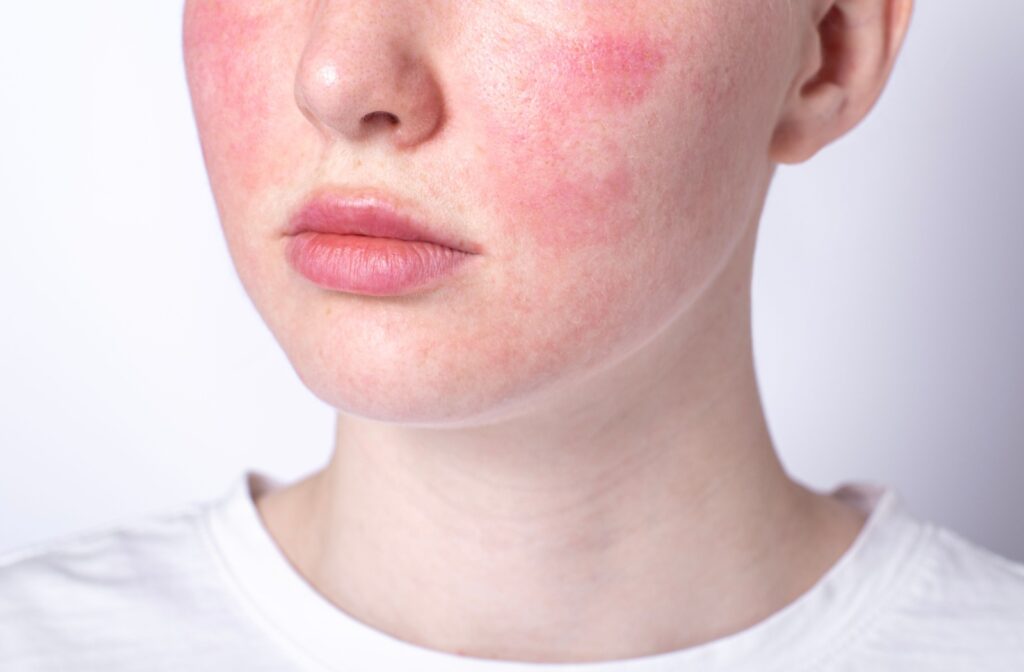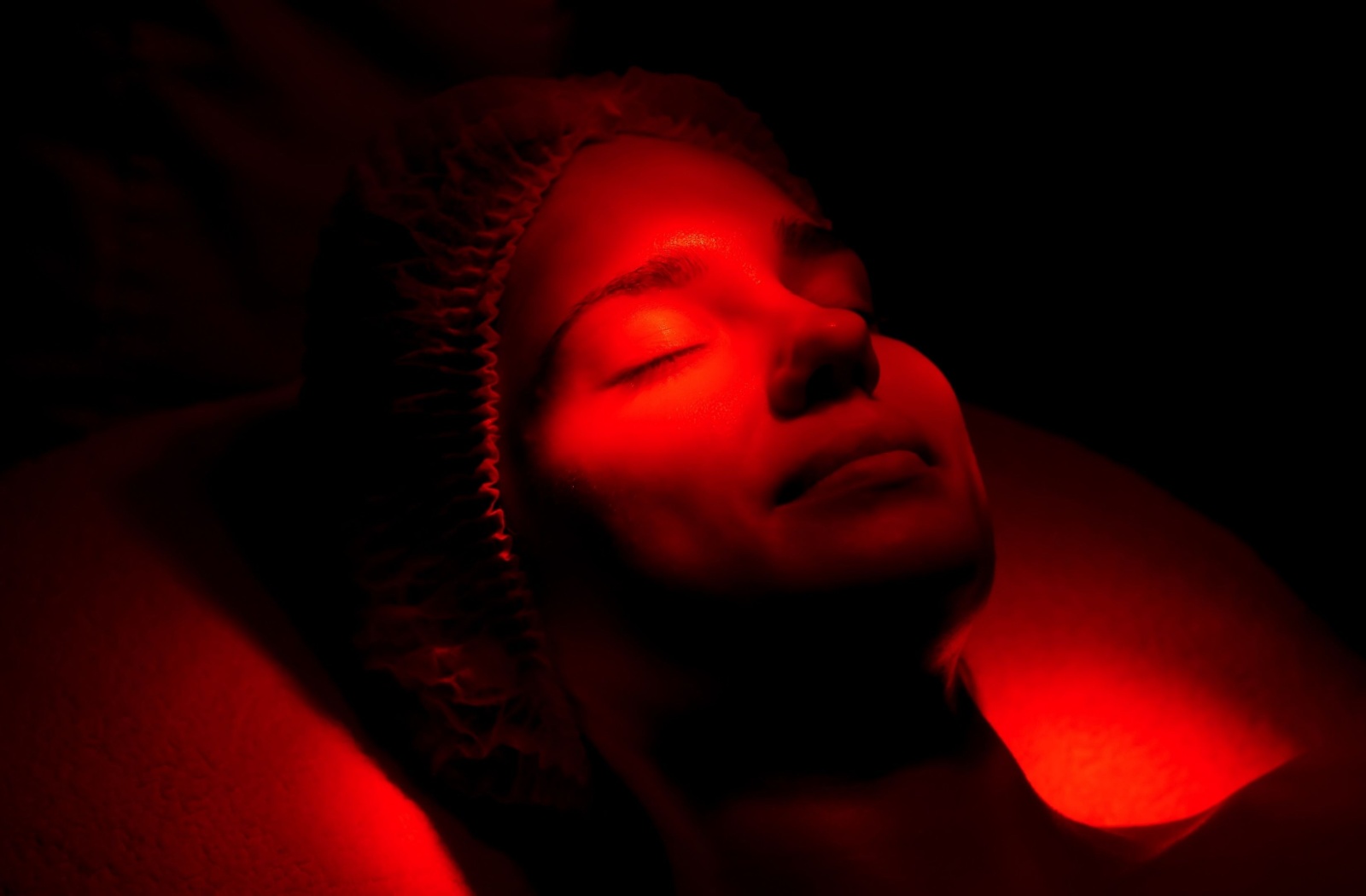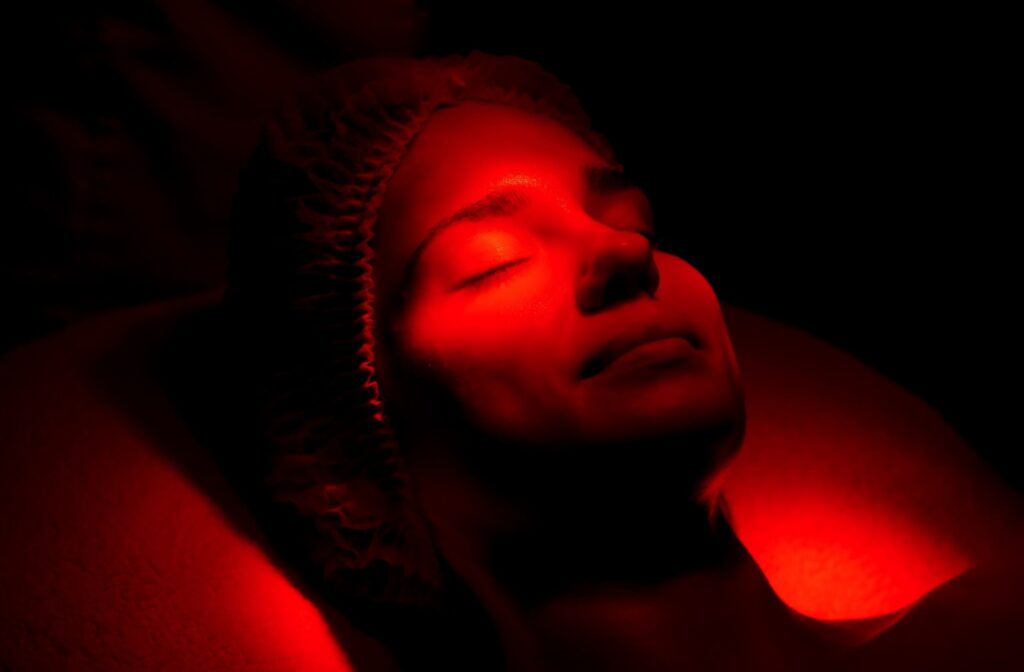If your face often looks red or feels irritated, you might be dealing with rosacea, a common skin condition that affects millions of people. The persistent flushing, visible blood vessels, and burning sensations caused by this condition can make you feel self-conscious about your appearance. When rosacea progresses to involve the eyes, a condition called ocular rosacea, the burning & stinging can be very debilitating.
At Luminance Vision Optometry, we see many patients struggling with these symptoms. We understand how they can impact your daily comfort and confidence, and we encourage you to book an appointment to discuss possible treatment options in person.
Red light therapy can be an effective treatment option for rosacea by reducing inflammation, calming irritated skin, and helping to manage the chronic redness that characterizes this condition. This gentle, non-invasive approach works with your body’s natural healing processes to address the underlying inflammation that causes rosacea symptoms.
What Is Rosacea & Why Does It Happen?
Rosacea is a chronic inflammatory skin condition that primarily affects your face. The onset is typically in adults over 30 and tends to worsen over time without treatment.
The exact cause remains unclear, but we know that factors like genetics, immune system responses, and environmental triggers all play a role. The blood vessels of people with rosacea may also be more reactive than normal, leading to the characteristic flushing and redness.
Common Signs You Might Notice
- Persistent facial redness
- Visible blood vessels on your face
- Red bumps or acne-like breakouts
- Burning or stinging sensations
- Eye irritation or dryness
The Four Types of Rosacea
Erythematotelangiectatic rosacea causes persistent redness and visible blood vessels across your cheeks and nose. Papulopustular rosacea creates red bumps and pus-filled lesions that look similar to acne breakouts.
Phymatous rosacea leads to skin thickening, particularly around your nose area. Ocular rosacea affects your eyes, causing dryness, irritation, and sometimes vision problems that require specialized eye care attention.
You can have more than one type of rosacea at the same time, and symptoms often overlap between different forms. Each type responds differently to different treatments, which is why personalized care matters so much.
How Red Light Therapy Works on Your Skin
Red light therapy works by using red and near-infrared light to penetrate your skin and stimulate cellular processes.
The Science Behind Light Wavelengths
When red light reaches your skin cells, it gets absorbed by structures called mitochondria.. This absorption triggers increased production of ATP (adenosine triphosphate), which gives your cells more energy to repair and regenerate.
The wavelengths used in red light therapy can penetrate deeper into your skin than other types of light. This deeper penetration allows the treatment to reach the areas where rosacea-related inflammation occurs.
How Red Light Reduces Inflammation
Red light therapy helps reduce inflammation by modulating your immune system’s response. It can decrease the production of inflammatory molecules while increasing anti-inflammatory compounds in your skin.
The treatment also improves blood circulation and lymphatic drainage in the treated area. Better circulation helps remove inflammatory waste products while delivering nutrients that support healing. According to the National Eye Institute, reducing inflammation is important for managing various eye and skin conditions.
Over time, this process can help calm the persistent inflammation that causes rosacea symptoms. Your skin may appear less red and feel more comfortable as the inflammatory response decreases.
Red Light Therapy Benefits for Rosacea
Red light therapy offers multiple benefits that directly address the underlying mechanisms of rosacea. The treatment works gradually to improve your skin’s appearance and comfort level. Our Low-Level Light Therapy services provide professional-grade treatment options for optimal results.
Targets Facial Redness & Flushing
The anti-inflammatory effects of red light can help reduce the persistent redness that characterizes rosacea. Many people notice their baseline skin tone becomes more even with consistent treatment.
Red light therapy may also help your blood vessels become less reactive to triggers. This can mean less intense flushing episodes and quicker recovery when flare-ups do occur.
Soothes Inflamed & Irritated Skin
If your skin feels hot, tight, or uncomfortable, red light therapy can provide relief by promoting healing and reducing the burning or stinging sensations that often accompany rosacea.
The gentle nature of light therapy makes it suitable for sensitive rosacea-prone skin. Unlike some treatments, which can cause irritation, red light therapy typically feels comfortable during and after sessions.
Helps With Different Types of Rosacea
Red light therapy can benefit multiple types of rosacea by addressing the common factor of inflammation. Whether you have persistent redness, bumps, or eye symptoms, the anti-inflammatory effects of red light therapy may help.
For ocular rosacea, red light therapy may help reduce inflammation around your eyes. This can lead to improved comfort and potentially better tear production if dry eyes are part of your symptoms.
What to Expect From Red Light Treatment
Red light therapy is a gradual process that requires consistency to see optimal results. Most people begin to notice improvements after several weeks of regular treatment sessions.
How Long Treatment Takes to Show Results
You might start seeing subtle improvements in skin comfort and reduced inflammation within 2-4 weeks of starting treatment. More noticeable changes in redness and overall skin appearance typically develop over 6-12 weeks.
The timeline can vary based on your individual skin condition and treatment frequency. Some people respond more quickly, while others need longer to see significant changes.
Consistency matters more than intensity with red light therapy. Regular sessions tend to produce better results than sporadic, longer treatments.
Best Light Colors for Your Rosacea Type
Red light around 660 nanometers works well for surface-level inflammation and redness. Near-infrared light at 850 nanometers penetrates deeper and can address inflammation in lower skin layers.
Many devices combine both wavelengths to provide comprehensive treatment. Your skin type and rosacea symptoms can help determine which wavelength combination works best for you.
Home Devices vs Professional Treatment
Home devices offer convenience and can be cost-effective for long-term use. However, professional treatments typically use more powerful devices that may produce faster or more dramatic results.
Professional treatments also come with expert guidance to ensure you’re using the therapy correctly. This can be particularly valuable when you’re first starting red light therapy for rosacea.
Many people find success with home devices once they understand how to use them properly. The key is choosing a quality device with the right wavelengths for rosacea treatment.
Other Ways to Manage Your Rosacea

Red light therapy works well as part of a comprehensive rosacea management plan. Our integrated approach includes IPL treatment options that can complement red light therapy for enhanced results.
Daily Skincare That Won’t Irritate
Choose gentle, fragrance-free cleansers and moisturizers designed for sensitive skin. Avoid products with alcohol, harsh acids, or strong fragrances that can trigger flare-ups.
Mineral sunglasses with zinc oxide or titanium dioxide can protect your skin without causing irritation. Sun protection is particularly important for rosacea-prone skin.
Apply products gently with your fingertips rather than rubbing vigorously. Your skin may be more sensitive than normal, so gentle application helps prevent additional irritation.
For Dr. Mei Fleming’s rosacea-friendly morning skincare routine and evening skincare routine recommendations, visit her You Tube Channel.
Common Triggers to Avoid
Heat, spicy foods, alcohol, and stress are common rosacea triggers for many people. Keeping track of your personal triggers can help you avoid unnecessary flare-ups.
Hot beverages, saunas, and intense exercise can also worsen symptoms. You don’t need to avoid these completely, but being aware can help you prepare and potentially minimize reactions.
When to Consider Professional Help
If your symptoms significantly impact your daily life or self-confidence, professional treatment can make a real difference. We offer various options beyond red light therapy, including other aesthetic treatments that can help improve your skin’s appearance.
Eye symptoms like persistent dryness, irritation, or vision changes deserve professional attention. These symptoms can sometimes indicate more serious complications that need proper care.
Learn more about rosacea and treatment options by watching our informative video: What is rosacea and how to treat at https://youtube.com/shorts/MSHSL9sOlGU?si=PN0_N0JZLCvMgvUX
Red Light Therapy Safety & What to Know
Red light therapy is generally safe for most people when used properly. However, there are some important considerations to keep in mind before starting treatment.
Who Should Avoid This Treatment
If you’re pregnant or breastfeeding, it’s wise to postpone red light therapy until after this period. People taking certain medications that increase light sensitivity should also exercise caution.
Those with active skin cancer or suspicious lesions in the treatment area should avoid red light therapy until cleared by a healthcare provider. If you have any concerns about your skin, professional evaluation is always recommended.
How to Use Red Light Safely at Home
Start with shorter treatment sessions and gradually increase time as your skin adjusts. Most home devices recommend starting with 10-15 minute sessions several times per week.
Keep your eyes protected during treatment sessions, either by closing them or by using appropriate eye protection. Position the device at the recommended distance from your skin to avoid overexposure.
Pay attention to how your skin responds and adjust accordingly. If you notice increased irritation or unexpected reactions, reduce frequency or consult with a professional.
At Luminance Vision Optometry, we understand how rosacea can affect both your skin and your eyes, especially when dealing with ocular rosacea symptoms like dryness and irritation. Our comprehensive approach will treat the root cause of rosacea and prevent its progression. Book at ‘Dry Eye Evaluation’ visit to learn more about red light therapy and other treatment options that can help you achieve healthier, more comfortable skin and eye health.




